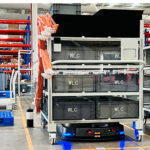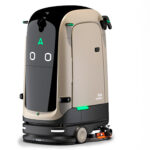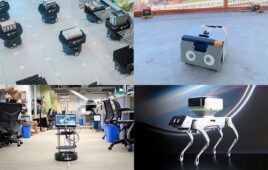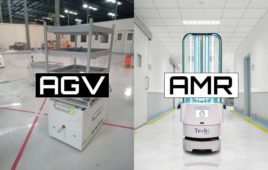Autonomous mobile robots are emerging as a viable solution to the automation of material handling processes in your factory or warehouse. However, the market is still maturing, and there are many vendors offering a range of solutions. With so many options, it’s critical to know the minimal feature set for a viable mobile robot system. This article outlines the 5 critical features of any industrial mobile robot system:
- Integrated safety
- Wireless communication
- Fleet management software
- Fleet simulation software
- Integration to supervisory software
Many of the existing vendors have some part of each of the above features in their current feature set and likely have the other features somewhere on their roadmap. The first three are absolutely critical features, and you shouldn’t consider any vendor who can’t demonstrate these features. The last two features are quickly going to be important to proving your return on investment for the solution, thus evaluating these features prior to purchase will help you grade the maturity of your vendor of choice.
1. Safety first
Mobile robots run autonomously and are designed to share unguarded space with humans. Unlike Automated Guided Vehicles (AGV) which are designed to stay in their own preallocated traffic lanes within the factory, mobile robots are designed to operate in the same aisles as humans and all of the other vehicle traffic in your factory or warehouse (fork trucks, tuggers, bicycles, delivery carts, etc). Therefore safety is critical to prevent the mobile robot from running into their human coworkers or any of the other obstacles in the environment. A mobile robot must have a robust sensor technology to identify an object in its path so that it can avoid hitting it. One of the most commonly deployed sensors for mobile robot navigation and obstacle avoidance is a horizontal LIDAR (scanning laser) on the front of the robot. There are now international safety regulations which prescribe the usage and function of these safety devices. You can learn more by looking at the regulations for ANSI/ITSDF B56.5-2005 and EN 1525. Your mobile robot vendor should have a manufacturer’s declaration of compliance (MDOC) for all of the necessary regulations, review the vendor MDOC before making any purchasing decisions.
Every mobile robot is going to be equipped with an application payload and the robot is going to transport some cargo which will sit above the deck of the vehicle. Therefore the mobile robot must have some method for detecting obstacles in the environment which exist above the plane of its navigation laser. This might include obstacles such as ladders, table tops and fork trucks forks. Likewise, material which might be found on the floor and below the view of the navigation laser can also present an unseen obstacle for the vehicle navigation (i.e. empty pallets, lowered fork truck forks and other debris). 3D vision and 3D laser scanners are quickly emerging as robust and viable options for detecting low hanging obstacles in the path of the robot, however these technologies require additional processing power (i.e. battery consumption) and processing time to compute. The use of 3D-based sensors is still limited to early prototypes. 3D vision is also susceptible to poor lighting conditions which can confuse the image processing. The state of the art today remains 2D LIDAR for the safety and obstacle avoidance functions on a mobile robot.
2. Wireless communication
Mobile robots are typically designed to communicate wirelessly with each other and with the robot supervisory system during normal operation. Therefore the mobile robot fleet must have the ability to communicate effectively over Wi-Fi within your factory, and have robust and secure programming and control interfaces available on both PC’s and handheld devices (cellphones and tablets). Network security is critical for most industries and companies today. The mobile robot system needs to operate within the network security requirements of your organization, and they also require adequate Wi-Fi coverage in your plant or facility. Be sure to include your IT department in the mobile robot system selection process and to include any additional Wi-Fi coverage in the cost and timing for your mobile robot deployment project. Depending on the Wi-Fi network traffic on your factory floor, you might need to deploy an additional Wi-Fi network exclusively for the use of the mobile robot fleet.
3. Fleet Management
While you might start your deployment with a pilot project consisting of a single mobile robot. It’s unlikely that your full return on investment (ROI) isn’t going to be achieved without the interaction of multiple vehicles. In the same way that you employ front line managers for the human workers in your plant, you need a virtual front line manager for your fleet of mobile robots. This front line manager comes in the form of a fleet management system developed by the mobile robot vendor, and it may include functions such as:
- Task management and job queuing
- Payload management (cart and payload change-over)
- Error handling and recovery
- Traffic management & optimization
- Charging and battery management
- Fleet configuration management
- Aggregate production statistics & history for the fleet
4. Fleet simulation software
One of the key selling features for mobile robot systems is process improvement. Early in the evaluation process, it may be easy to frame throughput improvement in simple terms using a spreadsheet, however the real world in which your new mobile robots will be deployed is likely to be more chaotic than can be evaluated effectively in a spreadsheet. The throughput of a complex material handling process with multiple delivery vehicles and a variety of pickup and drop-off locations can only be evaluated by running a simulation of the proposed system. (Or alternatively, an onsite feasibility study). Simulation, however, is currently one of the most difficult problems to solve accurately for a mobile robot fleet. Simulating traffic flow on the factory floor while trying to optimize the material delivery is a challenge for even the brightest computer scientists. Be skeptical of any mobile robot vendor who hasn’t made (or isn’t making) the investment into a viable simulation solution for their mobile robot products. Fleet simulation is a key product feature, not an add-on. Once your fleet is deployed and operational, you will leverage the fleet simulation functionality to verify programming and configuration changes before implementing changes in the real fleet.
5. Integration to IT systems
Let’s face it, the world has evolved beyond the simple automation system solutions of the late nineties where factory automation was typically an island. Every successful company now depends on its IT systems to manage the flow of information throughout the company. From order to ship, your production or warehouse control software will manage the high-level production information flow and track the material movement throughout your plant. Signals and messages from the production control software need to be exchanged with the fleet management software layer for the mobile robot system. The integration of the mobile robot fleet into the material process flow will add cost to the entire project, so make sure that the mobile robot solution has the appropriate application interfaces or integration tools to enable this critical data exchange.











Tell Us What You Think!
You must be logged in to post a comment.